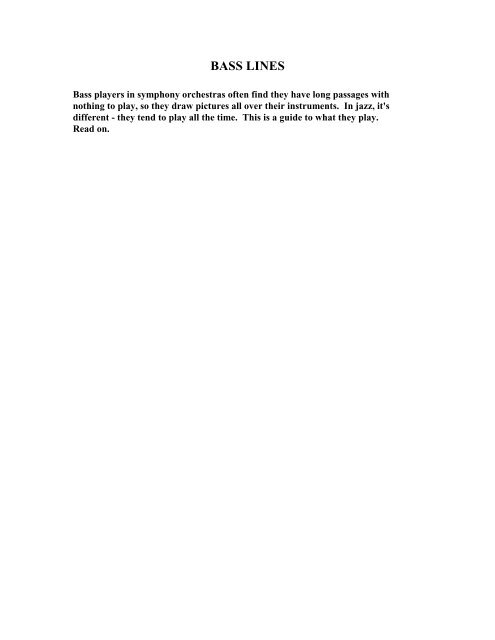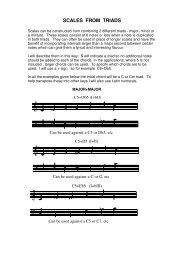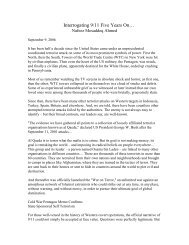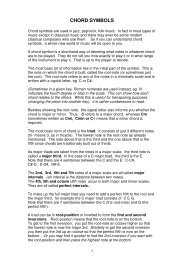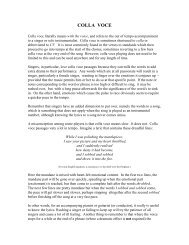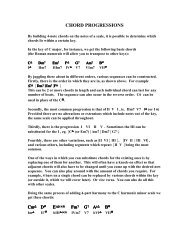Bass lines from chord symbols - Scored Changes
Bass lines from chord symbols - Scored Changes
Bass lines from chord symbols - Scored Changes
You also want an ePaper? Increase the reach of your titles
YUMPU automatically turns print PDFs into web optimized ePapers that Google loves.
BASS LINES<br />
<strong>Bass</strong> players in symphony orchestras often find they have long passages with<br />
nothing to play, so they draw pictures all over their instruments. In jazz, it's<br />
different - they tend to play all the time. This is a guide to what they play.<br />
Read on.
BASS LINES FROM CHORD SYMBOLS<br />
Constructing bass <strong>lines</strong> <strong>from</strong> <strong>chord</strong> <strong>symbols</strong> is not only a useful skill but is regarded as<br />
essential in most forms of music outside of classical music.<br />
The bass note of the <strong>chord</strong> is the most important note and will usually be played on<br />
the first beat of the bar or where the <strong>chord</strong> changes. The second most important note<br />
is the fifth of the <strong>chord</strong> ie. the note a perfect fifth above the bass note.If the 5th is<br />
altered, that is, lowered or raised it will be indicated in the <strong>chord</strong> symbol.<br />
Eg in a C <strong>chord</strong>, the fifth is the G.<br />
In a C7(-5),sometimes written as C7 (b5) the note in question is the Gb (or F#).<br />
In a C7(+5), sometimes written as C7(#5) the note in question is the G# (or Ab).<br />
Note that where the bass plays just root and fifth <strong>lines</strong>, the fifth is usually played<br />
below the root, ie. down a perfect 4th.<br />
Root and fifth <strong>lines</strong> are found in a lot of march tunes, older show tunes and in<br />
different types of Latin American music such as sambas, bossa novas, beguines, cha<br />
chas, and many mambos and salsa tunes. It is also found in older dance band tunes.<br />
=<br />
G G H ‹ H {<br />
The second version is more common in Latin music.<br />
H †<br />
In jazz or dance music which has a swing feel, you will often need to play 4 notes to a<br />
bar. It was once fashionable to double up the notes - CCGG, for example but this is<br />
now very old hat. Where you get <strong>chord</strong> changes which occur every 2 beats, you may<br />
get away with playing just the root notes, repeating each one but this is not<br />
recommended for a long passage. Even so, it is best to go up or down the octave to<br />
give a bit of variety.<br />
A better plan, where the <strong>chord</strong> changes every 2 beats is to play another note in the<br />
<strong>chord</strong> on the second and fourth beats. It is also possible to play the note a semitone<br />
below the root note of the next <strong>chord</strong> on those beats.<br />
Where the <strong>chord</strong> changes last for 4 beats or more, you have two main options:<br />
to play arpeggios or scalar passages.<br />
To play arpeggios you must take note of the type of <strong>chord</strong>, thus:<br />
a major <strong>chord</strong> (or major 6th or major seventh) has a major 3rd.<br />
a minor <strong>chord</strong> (or minor 6th or minor seventh) has a minor 3rd.<br />
a dominant seventh <strong>chord</strong> (denoted by a 7,9,11 or 13th) has a major 3rd and a minor<br />
7th (note)<br />
a diminished <strong>chord</strong> has a minor 3rd and a flattened 5th and a sixth<br />
a half-diminished <strong>chord</strong> has a minor 3rd and a flattened fifth and a minor 7th.<br />
Thus, 4 notes on a C <strong>chord</strong> could be:
C E G C, C E G E, C E G A, C E G B<br />
C G E C, C G E G, etc.<br />
In a C minor <strong>chord</strong>, substitue Eb's for the E's.<br />
In the other method, you can use scalar passages to link up <strong>chord</strong>al notes, eg.<br />
CDEG CEFG CGFE CGAB, CGED<br />
Where you see a slash <strong>chord</strong>, eg Dm7/C, it means Dm7 on C so it is important<br />
to play the note after the slash. (ie have a slash and then play the note).<br />
For long passages on the one <strong>chord</strong> the bass has a lot more liberty to play interesting<br />
<strong>lines</strong> instead of just the functional notes, particularly where a modal feel is required.<br />
Apart <strong>from</strong> playing 4's ("walking"), the bass can also play a more broken-up line.<br />
This approach has been around for some time. When a 2-feel occurs, the bass can<br />
play the root on the the first beat and then fill in for the rest of the bar but still<br />
maintaining the 2-feel. A more open broken-up feel, pioneered by such people as<br />
Scott LaFaro with the Bill Evans Trio, is characterised by its strong counterpuntal<br />
<strong>lines</strong>.<br />
Good bass playing is often a mixture of scales and arpeggios. The best way to learn<br />
how to do it is to learn about <strong>chord</strong>s and the scales to which they are related and<br />
practice until it becomes natural.<br />
Footnote: With bands shrinking in size it is becoming increasingly important for<br />
pianists to be able to play a bass line in their right hand. This is a skill that needs to<br />
be worked at. Concentrate first on getting the right notes (especially the root notes)<br />
and playing in time. Then try and develop <strong>lines</strong>. It is often useful to have a few<br />
patterns under your belt so that when your right hand is having to play something<br />
important you can put your left hand on automatic pilot.
A GUIDE TO BIG BAND BASS PLAYING<br />
Playing in a big band requires a very different mentality <strong>from</strong> playing in a combo.<br />
Each has its merits; on the other hand each has its share of problems. These notes,<br />
written <strong>from</strong> the vantage point of an arranger, may help you to get round some of the<br />
difficulties of playing in a big band and shed some light on what is expected of you.<br />
Combos are ideal for innovative jazz-playing and provided all of the players are<br />
competent and sympathetic to one another can be extremely flexible, allowing tempo<br />
changes, alternative <strong>chord</strong>s and impromptu changes of rhythm with relative ease.<br />
Musicians are also able to cover up mistakes (skipped beats/ bars, wrong notes, etc) so<br />
as to be imperceptible to the majority of listeners. Yet all too frequently this can be<br />
taken to extremes and the playing can become slapdash and the self-indulgence of<br />
players can overshadow the cohesiveness of the group.<br />
Big bands by their very nature are less flexible and require more discipline <strong>from</strong> each<br />
of the players. All it needs in a horn section is for one person to play wrong notes or<br />
timing or not to observe the dynamics and the whole section or ensemble suffers. The<br />
band will sound amateurish and individual members will become disgruntled.<br />
Fortunately, the sacrificing of a certain amount of self-expression is made up for by<br />
other things. A really tight big band can provide a wonderful sense of exhilaration,<br />
particularly in punchy passages, while soft sustained <strong>chord</strong>s in a ballad can ooze<br />
warmth. The range of tone colours and variations of texture and intensity are<br />
tremendous and the ability to interweave <strong>lines</strong> against each other and to layer them on<br />
top of one another cannot be duplicated by a small band.<br />
There are other advantages <strong>from</strong> playing in a big band. Many great players, (Parker,<br />
Gillespie, Brookmeyer, Getz, Phil Woods, Kenny Wheeler, etc) "served an<br />
apprenticeship" in a big band. Many of them have acknowledged the usefulness of the<br />
discipline that is needed, plus the help it provides in reading music. These benefits<br />
can then be applied to small-group settings.<br />
So what about the bass? The bass is one of the king-pins in a big band. It has a<br />
number of functions. The bass has to provide the root-notes of the <strong>chord</strong>s. Omit<br />
the root-notes and the whole edifice can collapse. In the Swing Era, most of the<br />
harmony was firmly anchored by the baritone sax or the bass trombone or sometimes<br />
by both in unison. The bass player was often merely reinforcing the root-notes a lot of<br />
the time. This is no longer the case. Nowadays, the trombone or sax section is not<br />
voiced <strong>from</strong> the root but <strong>from</strong> the next voice up. Similarly, in a lot of flowing<br />
ensemble passages, there is no root-note present on the bottom. The lowest voice in<br />
the horns may be in the octave below middle C. Therefore the bass must play the<br />
root-note where necessary (1st beat of the bar usually) and it must provide a<br />
counterweight to the powerful upper voices in the trumpets and saxes in its most<br />
powerful and resonant register.<br />
The bass must also provide the beat. The drums also have this function, but it is the<br />
bass with its definite pitch which is the main prompt to the horn players in
determining where they are. If follows then that the bass line must be well-defined<br />
and easy to follow for the sake of the rest of the band. Simple <strong>lines</strong> with few notes are<br />
often what is required to help keep the band together. If one section gets adrift <strong>from</strong><br />
another section, it is almost impossible to get everyone together again for quite a time.<br />
(Sections are guided by the lead-players and if one person gets out, they all do.)<br />
When it comes to a solo backed just by the rhythm section, the bass can have more<br />
freedom but it is as well to guide the rest of the band in when the time comes (usually<br />
near a rehearsal mark).<br />
The bass is sometimes called upon to bolster up a passage in the low register, in<br />
unison with the trombones, low saxes or piano. Accuracy is what is called for here,<br />
so reading the written part as is is very important. Nevertheless, because the part is<br />
covered by other instruments, it can if necessary be simplified.<br />
The bass may have to depart <strong>from</strong> its walking line to play a rhythmic figure with<br />
a section or with the rhythm section or sometimes with the ensemble. In this instance,<br />
there is little scope for simplication - unless the part is impossible to play.<br />
The bass is also a part of the rhythm section and must function as part of a team<br />
within a bigger team. In this respect the bass player's job is the same as in a combo.<br />
There are other points which arise out of these functions which are important.<br />
The dynamic level is usually far higher than with a small band. To play loudly or<br />
louder than you may be used to can take some getting used to, especially if you are<br />
unsure of the parts. But be brave. If you play too softly and you are not heard by<br />
everyone the band can collapse. Although dynamics may not be marked on the part,<br />
you will have to judge the level yourself and play quieter in soft passages and behind<br />
solos with no horn backing than in shouting passages.<br />
Good intonation is vital. Check your intonation with the piano as you play as the<br />
front-line players may be doing the same thing. But also try and blend in with the<br />
pitching of the horns. Intonation can be a problem if there is an out-of-tune player in<br />
the band or if the piano is out of tune. Certain big band players have a big thing about<br />
intonation - and quite rightly so, as a closely-voiced <strong>chord</strong> can sound dreadful if<br />
people are out of tune.<br />
Getting lost - It is easy to do and most people get lost at one time or another. The<br />
problem with playing bass is that if you are lost everyone will know. If the third<br />
trumpet gets lost, he can just lay out and others in the section will help him/her out.<br />
Counting is sometimes necessary to keep your place in the music. If you do get lost,<br />
listen out and try and find it again. You can also be helped by the conductor.<br />
A final problem that most bass players face is having to balance a long piece of music<br />
on a small music stand. Turning over a page can be difficult. Knocking over the stand<br />
with all the music on it can be easy. You can usually solve this problem by folding the<br />
music in a certain way, by memorizing a few bars where the turn occurs, or by putting<br />
a long piece of something lightweight under the music. Oh and if you can't see the<br />
music, do complain before you set fire to the music. Good luck.


